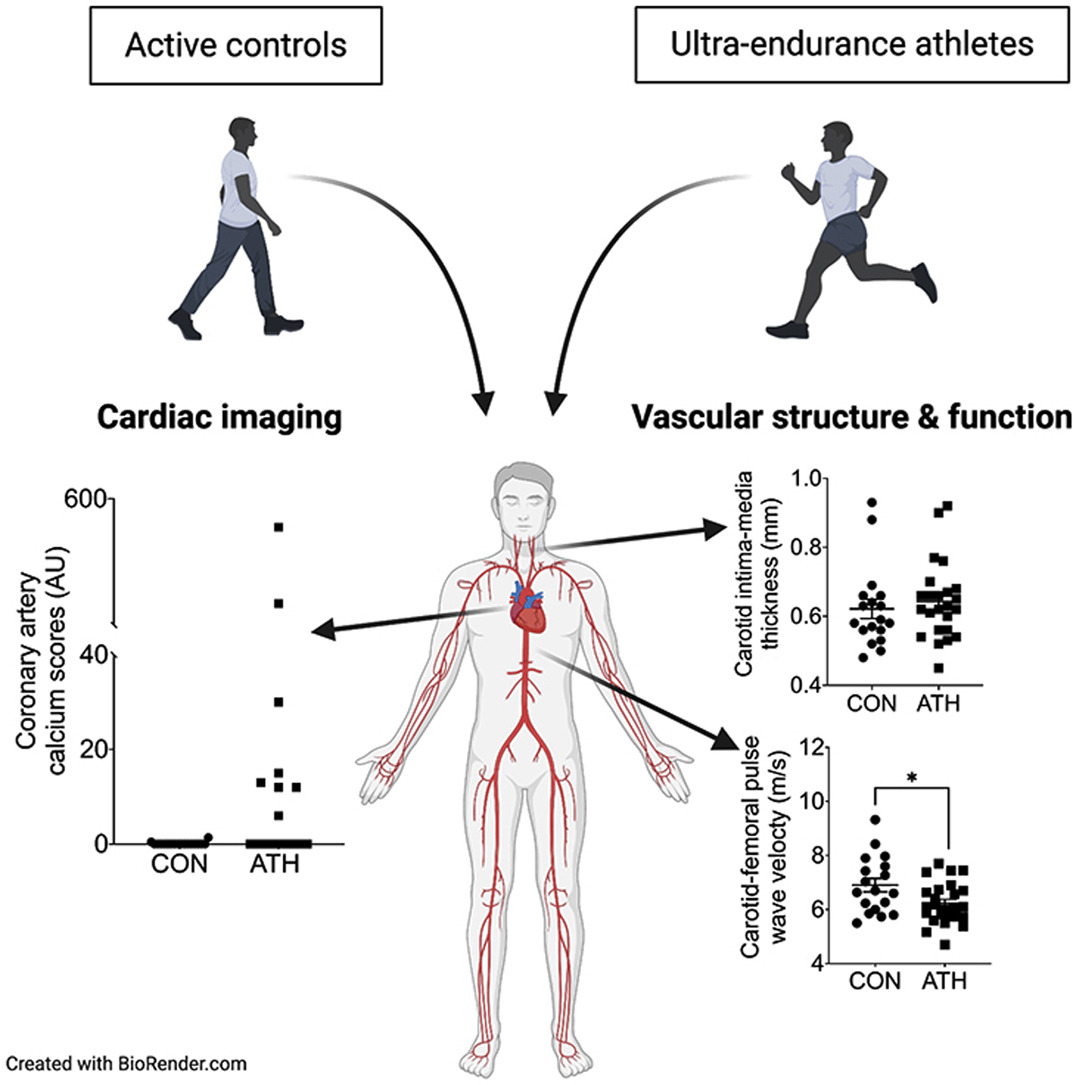
Some research has shown that ultra-fit athletes such as marathon runners can have cardiac damage such as heart scarring or arrhythmia, raising the question of whether too much aerobic exercise can be a bad thing.
But a recent study by Colorado State University found that while some ultra-athletes showed some minor calcium buildup in their coronary arteries, they were still healthier overall than a control group of people who only got moderate exercise.

The research project was conducted by Frank Dinenno, a professor in the Department of Health and Exercise Science, and Nate Bachman, a doctoral student in Dinenno’s Human Cardiovascular Physiology Laboratory. Supported by a $100,000 Programs for Research and Scholarly Excellence grant from the CSU Office of the Vice President for Research in 2016, Dinenno and Bachman worked with local cardiologists and other Health and Exercise Science faculty to examine 25 ultra-athletes in Colorado. The researchers also conducted assessments of 18 Coloradans who were moderately active.
A paper on the study, “Comprehensive assessment of cardiovascular structure and function and disease risk in middle-aged ultra-endurance athletes,” was published in December in the journal Atherosclerosis.
Selecting participants
According to Bachman, who conducted the majority of the research for the master’s thesis he completed in 2018, the ultra-athletes were healthy individuals between the ages of 40 and 65 who had been training and competing for at least 10 years in events like ultra-marathons and triathlons. The control group consisted of healthy subjects in the same age group who were getting at least 150 minutes of exercise per week. Both groups underwent a rigorous screening process to ensure that none of them had other health factors that might affect the results, such as obesity, high cholesterol or hypertension.

Dinenno and Bachman conducted a battery of vascular tests on the subjects in the lab, having them do an aerobic fitness test and assessing elements such as the stiffness of their carotid arteries and the dilation of vessels in their arms, for instance. Then the subjects were sent to the UCHealth Medical Center of the Rockies for echocardiograms of their heart structure/function as well as imaging of their coronary artery calcium levels. (Calcium deposits are a hardened plaque that can be a marker for cardiovascular problems, even when a person has no symptoms.) The participants also underwent cardiac fibrosis tests. The assessments were conducted between summer 2017 and the end of 2018.
By most measures, such as stiffness of the aorta and the elasticity and thickness of the carotid artery, the ultra-athletes had better cardiovascular health than the control group, and none of the subjects had any scarring on their hearts. But eight of the ultra-athletes had calcium deposits in their arteries, while only two in the control group had such deposits.
Overall health findings
Even though a higher percentage of the ultra-athletes had calcium deposits, their overall cardiovascular health was still better than those in the control group, leading the team to conclude that extreme amounts of cardio are not deleterious to one’s health.
What the team measured
Coronary artery calcium scores: hardened plaque in the coronary arteries; data collected using a cardiac CT scan. This measure is usually used in the medical setting as a screening technique for asymptomatic individuals over 40 who have intermediate coronary artery disease risk.
Echocardiography: structure and function of the heart, measured with ultrasound. This is used for clinical assessment to identify disease like heart failure or valve dysfunction.
Myocardial fibrosis: scarring of heart tissue; measured with cardiac MRI. This technique is not routinely used in clinical settings, but has been related to cardiac events in some patient groups.
Carotid-femoral pulse wave velocity: a measure of aortic stiffness, measured with specialized laboratory equipment. This is an independent predictor of cardiac events like heart disease and stroke.
Carotid compliance: essentially the opposite of stiffness (higher compliance is better), measured with ultrasound. It’s a good measurement to understand how blood vessel function is different between two groups.
Carotid intima-media thickness: thickness of the carotid artery wall. It is measured with ultrasound, and it is also predictive of cardiac event risk and can be elevated due to arterial plaque accumulation.
Brachial artery endothelial function – changes in artery diameter in response to an increase in blood flow. It is independently predictive of cardiac event risk and can be reduced in populations at risk for cardiovascular disease.

When other risk factors such as blood pressure, cholesterol and age were used along with the calcium score to determine heart disease risk, most of the athletes were below the threshold for statin treatment.
The researchers plugged all of their data into a risk calculator for coronary heart disease and found that the ultra-athletes were not at higher risk than the control group.
“We didn’t find evidence that would make us recommend that people not exercise too much,” Bachman said. “The overall benefits of exercise outweigh anything we saw.”
The researchers added, however, that some people may have other health factors, such as a family history of heart disease, that they should discuss with their doctor before becoming ultra-athletes.
“There are probably some people who shouldn’t be doing this much exercise,” Bachman said.
More common in men
Seven of the eight ultra-athletes who had calcium deposits were men, which Dinenno and Bachman say is consistent with other studies that have shown that calcium tends to show up earlier and at higher levels in men than in women.
“In addition to helping us understand some basic and clinical cardiovascular physiology of ultra-endurance athletes, this was a true collaborative effort with the UCHealth Heart and Vascular Center,” said Barry Braun, a co-author and head of the Department of Health and Exercise Science. “We worked together, from asking the initial questions, to making sophisticated measurement of cardiac structure and function, to editing the final manuscript.”
In addition to Braun, the researchers’ co-authors on the paper were doctoral student/alumna Janée Terwoord, Assistant Professor Jennifer Richards, as well as Dr. Patrick Green and Dr. Gary Luckasen, both of whom are cardiologists at the Medical Center of the Rockies.
Bachman said he learned a lot during the collaborative study.
“I was very green at the beginning of this process,” he said. “This project really threw me into the research world. It was a lot of work on everyone’s part, and it was truly a group effort.”
The Department of Health and Exercise Science is part of CSU’s College of Health and Human Sciences.